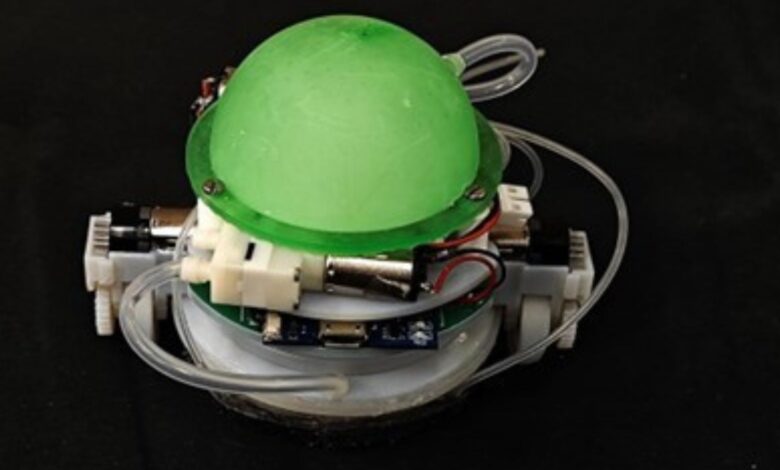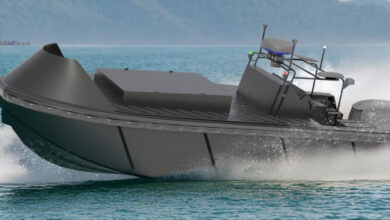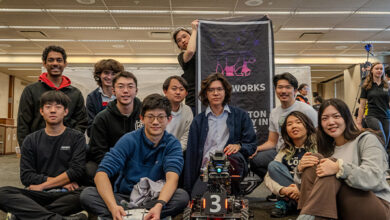This water-powered robot climbs like a snail, but leaves no mess

Researchers at the University of Bristol have developed an efficient climbing robot mechanism inspired by snails.
The team at Bristol Robotics Laboratory equipped a robot with a sliding suction technology that allowed it to glide on water—a surrogate for a snail’s mucus that doubles as an adhesive.
The new method adds to the number of inventive ways robots may traverse. Researchers claim sliding suction offers a low-cost, energy-efficient, high-payload, and clean adhesive locomotion method.
According to researchers, the approach holds significant potential for applications in climbing robots, outdoor inspection robots, and robotic transportation.
“The most exciting finding of our research it that the proposed sliding suction mechanism is a novel clean climbing strategy and will significantly advance the development of the next-generation climbing robots,” said Tianqi Yue, the study’s lead author, in a statement.
The details of the team’s research were published in the journal Nature Communications.
Efficient adhesion mechanism
Adhesion strategies enable robots to grip, manipulate, and climb by generating attractive forces between objects and surfaces.
Various adhesion methods for climbing robots include suction, electromagnetic adhesion, gecko adhesion, and electro-adhesion. These robots aim to maximize adhesive force for secure holding or perching.
However, higher adhesive forces increase friction between the adhesive pad and the substrate. To manage this friction, climbing robots use multiple adhesive pads that intermittently detach, move, and reattach, resulting in a discrete “walking” motion.
This approach has several drawbacks: frequent breaking and regenerating of adhesive forces; complex, heavy transmission structures; energy wastage during pad repositioning; and reduced total adhesive force during movement due to some pads being detached.
With just one high-payload sucker, snails can glide across a surface steadily, providing future climbing robots with an effective adhesive locomotion mechanism. Mucus secretion, which lowers friction and increases suction, is essential to snails’ sliding suction behavior.
“Inspired by this, we presented a ‘sliding suction’ mechanism and developed a sliding suction robot, which achieved comparable sliding ability as snails,” said Yue.
Energy-efficient climbing mechanism
Given the significance of mucus in the sliding suction mechanism, the researchers employed water as an inexpensive, readily available, and hygienic substitute for real mucus to facilitate the robot’s sliding while the suction persisted.
They constructed the robot’s mechatronic system, optimized the suction cup’s materials, and demonstrated its usefulness by transporting a 200-gram mass and avoiding obstructions.
Additionally, the robot showed excellent loaded sliding ability when towing a 2.2-pound (1 kilogram) mass or ten times its own weight. A lightweight robot may achieve fast speeds by sliding vertically and upside down, using sliding suction to save energy during static adhesion.
According to researchers, the sliding suction mechanism enables a lightweight robot (96 g) to move vertically and upside down at high speeds (53°/s rotation and 19 mm/s translation) while carrying significant payloads (2.2-pound or 1 kilogram tested, 11.08 pound or 5.03 kg theoretically). This method also requires no energy to maintain adhesion.
“Through the performance of the sliding suction robot, we demonstrated that sliding suction offers low energy consumption, high adhesion efficiency and safety, high loading capacity, and low complexity while only leaving a quick-to-evaporate water trail,” said Yue.
Researchers highlight that the current design can only slide on smooth surfaces. Rough surfaces reduce performance due to leakage and increased friction but improve tire grip to prevent slipping.
Future designs might include a small vacuum pump to counteract leakage on rough surfaces, making it more energy-efficient than typical wall-climbing robots. The suction robot also can’t slide over steps, but future versions with multiple suction cups could handle uneven surfaces.
Adding sensors could enable precise, autonomous movement. Placing water tubes near the front, like a snail’s mucus gland, would improve climbing speed. Using super hydrophobic coatings on tires could prevent slipping in wet areas.
ABOUT THE EDITOR
Jijo Malayil Jijo is an automotive and business journalist based in India. Armed with a BA in History (Honors) from St. Stephen’s College, Delhi University, and a PG diploma in Journalism from the Indian Institute of Mass Communication, Delhi, he has worked for news agencies, national newspapers, and automotive magazines. In his spare time, he likes to go off-roading, engage in political discourse, travel, and teach languages.



